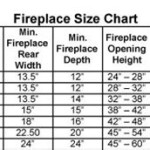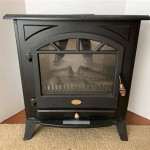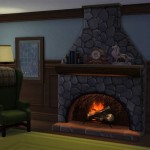Understanding the Appeal and Considerations of Used Gas Fireplace Inserts
Gas fireplace inserts offer a convenient and efficient alternative to traditional wood-burning fireplaces. They provide consistent heat output, require minimal maintenance compared to wood fireplaces, and can be operated with the flick of a switch. Investing in a used gas fireplace insert can be a cost-effective way to enjoy these benefits, but a thorough understanding of the advantages, potential drawbacks, and crucial considerations is essential before making a purchase.
A gas fireplace insert is essentially a self-contained heating unit designed to fit inside an existing fireplace opening. These inserts typically run on natural gas or propane and vent through an existing chimney or a direct vent system. Unlike traditional open-hearth fireplaces that lose much of their heat through the chimney, gas inserts are designed to radiate heat into the room, significantly improving heating efficiency. This makes them a popular choice for homeowners looking to supplement their existing heating system or to add supplemental heat to a specific area of the home.
The initial cost of a new gas fireplace insert can be substantial. This is where purchasing a used unit can offer significant savings. However, the lower upfront cost must be weighed against the potential risks associated with buying used appliances. Potential buyers must meticulously evaluate the condition of the insert, its remaining lifespan, and the availability of replacement parts. A comprehensive inspection and a clear understanding of the unit's history are crucial steps in making an informed decision.
Cost Savings vs. Potential Risks
The primary advantage of purchasing a used gas fireplace insert is the reduced price compared to a new model. The price difference can be significant, allowing homeowners to acquire a higher-quality insert than they could otherwise afford. This can be particularly attractive for those on a budget or homeowners looking to upgrade their existing fireplace without a major financial investment.
However, this cost saving comes with inherent risks. A used insert may have hidden problems that are not immediately apparent. These problems could range from minor issues, such as a faulty igniter, to more serious concerns like a cracked heat exchanger or a damaged gas valve. These issues can lead to costly repairs or even require the replacement of the entire unit. Therefore, a professional inspection is paramount to identify any potential problems before finalizing the purchase.
Furthermore, the lifespan of a used gas fireplace insert is obviously shorter than that of a new one. Depending on the age and condition of the unit, its remaining lifespan could be relatively limited. This means that the buyer may need to factor in the possibility of needing to replace the insert sooner than they would with a new model. Considering the cost of removal, disposal, and installation of a new unit, the long-term cost savings of a used insert may be less significant than initially perceived.
Another consideration is the availability of replacement parts. Older models may have obsolete parts that are difficult or impossible to find. This can create problems down the line if the insert requires repairs. Before purchasing a used unit, it is essential to research the availability of replacement parts for that specific model. Contacting the manufacturer or consulting with a qualified gas fireplace technician can provide valuable information in this regard.
Inspection and Evaluation Procedures
A thorough inspection of a used gas fireplace insert is absolutely critical. This inspection should ideally be performed by a qualified and licensed gas fireplace technician. The technician will be able to identify potential problems that may not be apparent to the untrained eye. This inspection should cover all aspects of the insert, including the burner assembly, gas valve, igniter, venting system, and heat exchanger.
The inspector will start by visually examining the insert for any signs of damage or wear. This includes checking for cracks, rust, or corrosion on the exterior and interior components. The inspector will also examine the glass door for any cracks or chips. The condition of the glass can be indicative of the overall care taken with the unit.
The next step is to test the functionality of the insert. This involves turning on the unit and observing the burner flame. The flame should be blue and steady, without any flickering or yellow tips. A yellow flame can indicate incomplete combustion, which can lead to the production of harmful carbon monoxide. The technician will also check the gas pressure to ensure that it is within the manufacturer's specifications.
The venting system is another critical area to inspect. The technician will check the vents for any obstructions or damage. A blocked vent can prevent proper exhaust of combustion gases, which can also lead to carbon monoxide poisoning. The venting system should also be properly sealed to prevent any leaks.
The heat exchanger is the component that transfers heat from the burner to the air. The inspector will check the heat exchanger for any cracks or leaks. A cracked heat exchanger can allow combustion gases to enter the living space, posing a serious health hazard. This is one of the most important components to check, as damage here can render the insert unsafe for use.
The technician will also conduct a carbon monoxide test to ensure that the insert is not leaking any carbon monoxide into the room. This test is essential to ensure the safety of the occupants of the home. Carbon monoxide is a colorless, odorless gas that can be deadly in high concentrations.
Venting and Installation Considerations
Proper venting is absolutely crucial for the safe and efficient operation of a gas fireplace insert. The venting system must be compatible with the insert and installed according to the manufacturer's instructions and local building codes. Improper venting can lead to carbon monoxide poisoning, fire hazards, and reduced heating efficiency.
Gas fireplace inserts typically use one of two types of venting systems: direct vent or B-vent. Direct vent systems draw combustion air from outside the home and exhaust combustion gases directly outside. This type of venting system is considered the safest and most efficient. B-vent systems use existing chimneys to exhaust combustion gases. These systems require careful inspection to ensure that the chimney is in good condition and that it is properly sized for the insert. B-vent systems are generally not recommended for newer, high-efficiency inserts.
The installation of a gas fireplace insert should always be performed by a qualified and licensed gas technician. The technician will ensure that the insert is properly connected to the gas supply and that the venting system is properly installed. The technician will also test the insert to ensure that it is operating safely and efficiently. DIY installation is strongly discouraged, as it can be dangerous and may void the manufacturer's warranty.
Local building codes may require permits and inspections for the installation of gas fireplace inserts. It is important to check with the local building department to determine the specific requirements in your area. Obtaining the necessary permits and inspections ensures that the installation is performed safely and in compliance with all applicable regulations.
Before installing a used gas fireplace insert, it is essential to have the existing fireplace and chimney inspected by a qualified chimney sweep. The chimney sweep will clean the chimney and check for any structural problems. A damaged or obstructed chimney can pose a serious safety hazard. The chimney sweep can also recommend any necessary repairs or upgrades to the chimney.
Ultimately, the decision to purchase a used gas fireplace insert should be based on a careful evaluation of the potential benefits and risks. A thorough inspection by a qualified professional, a clear understanding of the unit's history, and adherence to proper installation procedures are essential to ensure a safe and cost-effective outcome. The initial cost savings must be weighed against the potential for future repairs and the remaining lifespan of the unit. Taking the time to carefully consider these factors will help homeowners make an informed decision that meets their heating needs and budget.

New Used Fireplaces Ham Kent Gas Fireplace Insert

Preowned Used Fireplaces Stoves Inserts For At Warming Trends

A Step By Guide To Understanding Fireplace Inserts

New Used Fireplaces Ham Kent Gas Fireplace Insert

Fireplace Insert Installation Wood Inserts Gas Pellet And Electric

Fireplace Insert Guide Fireplaces Direct Learning Center

Do Gas Fireplaces Heat A Room Contact The Flame Company Today

Gas Burning Fireplace Inserts We Install

Fireplaces Inserts Wood Gas Fireplace Xtrordinair

How To Buy A Gas Fireplace Insert Buyer S Guide From Regency
Related Posts








